I have the feeling I need to preface this one with a huge disclaimer: More than any other game I can think of, Mr President is first and foremost a interesting challenge. It’s a challenge to learn, a challenge to play, a challenge to write about. And I’m not even sure I’m the right person to be writing about it. This is my first ever game from strategy/war game publisher GMT Games, my first ever multi-day solo-only experience game, and the first ever game I’ll be writing about without having played it over and over and over again. For those that don’t know me, even for my first impressions I typically do 8-10 full playthroughs which isn’t really possible in this case for reasons that will become apparent later on.
It’s also important to stress that while I like going beyond my comfort zone, I’m typically much more at home in the sphere of euro-games. The closest thing I have played to Mr President so far would be John Company Second Edition, which I enjoyed a lot and is one of the reasons I was interested in getting Mr President, and games like Cubra Libra (nothing like it at all) or Shogun (also nothing like it all) to name two “conflict games”. But it is exactly that outsider’s perspective that might proof valuable for those that are typically not the in the market for a game like Mr. President and still figuring out if it is for them or not.
So grab a fresh pot of your hot beverage of choice and dig in. I have a feeling this will turn out to be a fun but long one …
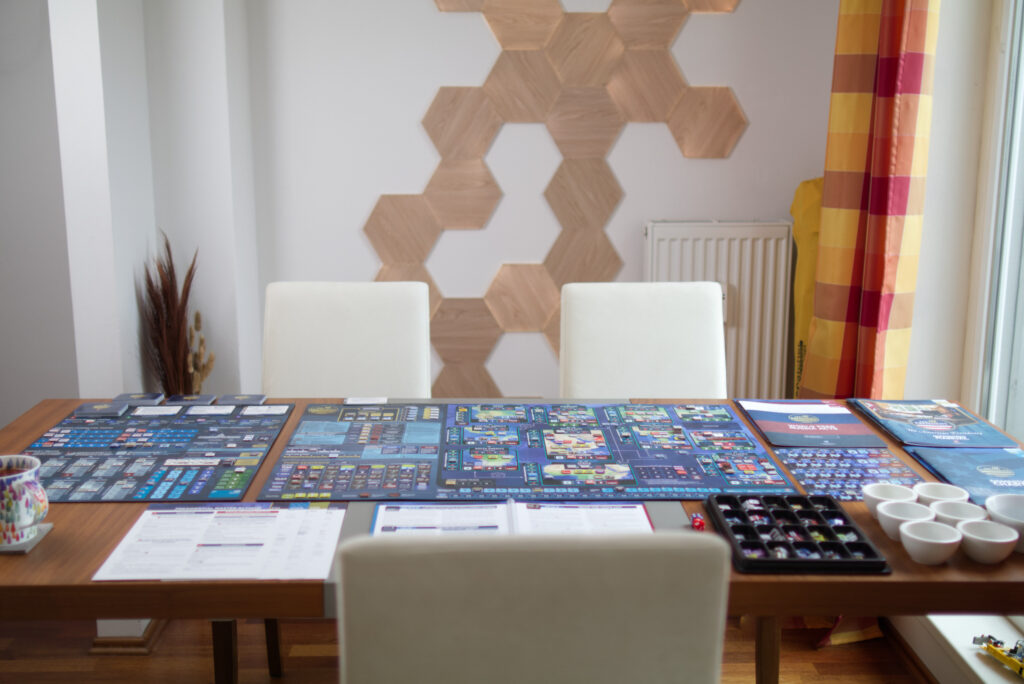
Setup
I’m used to heavy games, both in complexity and in physical weight, and it seems to be a recent trend to produce more and more games that are filled to (and sometimes beyond) the brim. Recent examples were Horseless Carriage, Now or Never, Hegemony, but I always think back fondly to the The Colonist. Mr. President fits right into that category with its hundreds of cardboard chits, two main and two side boards, a big stack of cards and a shear abundance of rule books and booklets. Which brings me to the first consideration for anyone thinking of buying Mr. President: you need dedicated table space, and lots of it.
To get the shot in the image above, I had to get my dinner table’s extension out and turn it into the larger 190x90cm version of itself. And don’t think you’ll be able to use that table in a while. The first time I set the game up took me around two hours and to play a single turn easily takes multiple hours! The long setup is in part due to the 200+ chits one has to place on the various boards to create the sandbox scenario but also due to the fact that the scenario book mentions things in a way that assume you are already familiar with the almost a hundred tracks on the board and even more chits available. Even with GMT trays (which are not included in the game), resetting one play to play another took me like 30-45min! So this is more a game you keep set up over a longer period of time and return to it whenever you feel like continuing your play. In order to not completely lose access to my dinner table for multiple weeks, I instead opted for using my couch table (main board), parts of the floor (domestic main board) and parts of the couch (war board, counters, booklets), which was quite a sight to behold.
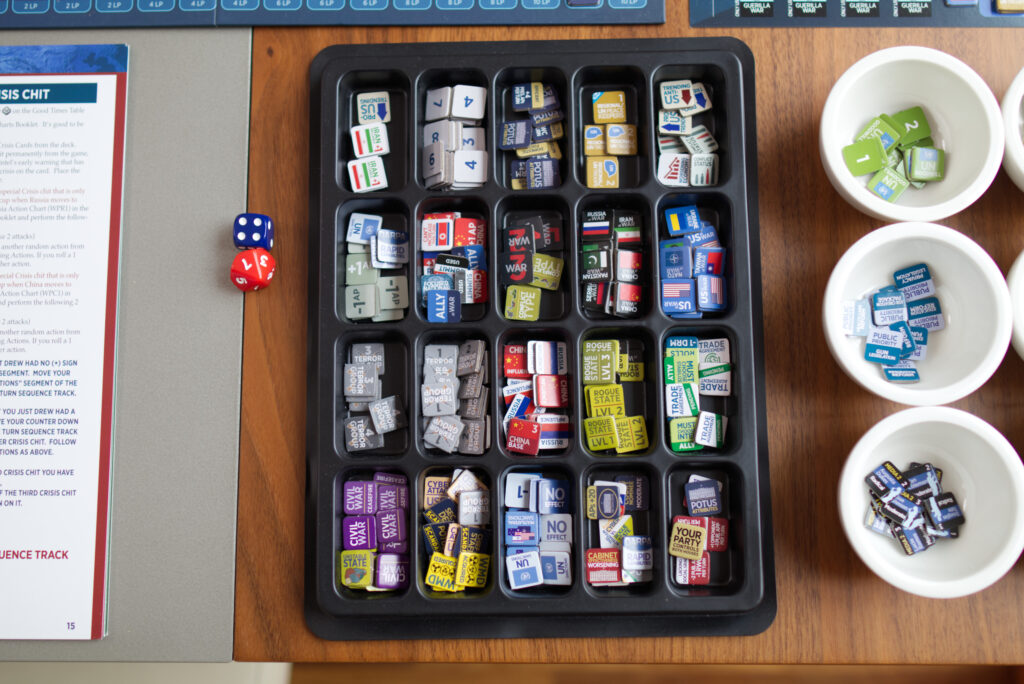
Mr President puts the player into the role of acting as POTUS, the president of the United Stated. There are three things that come naturally with this: a) things are more complicated than one might think, b) the perspective on the world is US-centric, and c) it’s all quite overwhelming to be in those shoes. Even going through all the components would take forever, so let me give you the cliff notes instead:
The central main board shows various regions in the world, most of them with tracks for the level of crisis, stability (which is a different dimension), alignment with the US, and the current state of tracking various terror groups. There are also the two big US-rivals Russia and China for which the game instead focuses more on their current attitude towards the US and the state of their economy. The euro zone interestingly is kind of a mix of both. A lot of tracks in Mr President are so called “trending tracks”: they typically don’t increase/decrease whole steps directly but instead first get an improvement/worsening counter and only actually move when they improve/worsen again (so it kind of takes two steps to move a single box).

In the top left of the central main board are special attributes you as the leader have, key members of your cabinet, various priorities for your cabinet, your administration and the public’s priorities (e.g. gun laws or health care). Let’s focus on the key cabinet members: during setup, you pick a VP, Chief of Staff, Secretary of State, and Secretary of Defense from a limited number of options. Each one comes with three attributes (domestic, diplomacy, military) that can influence how well they are doing and has a novice and expert side. If you’re lucky, you even get some that provide you additional actions. If you’re not so lucky, you end up with people that have great attributes … but not for the position they are in. Of course there are options to replace them during the game, but that runs the risk of causing the usual political scandals.
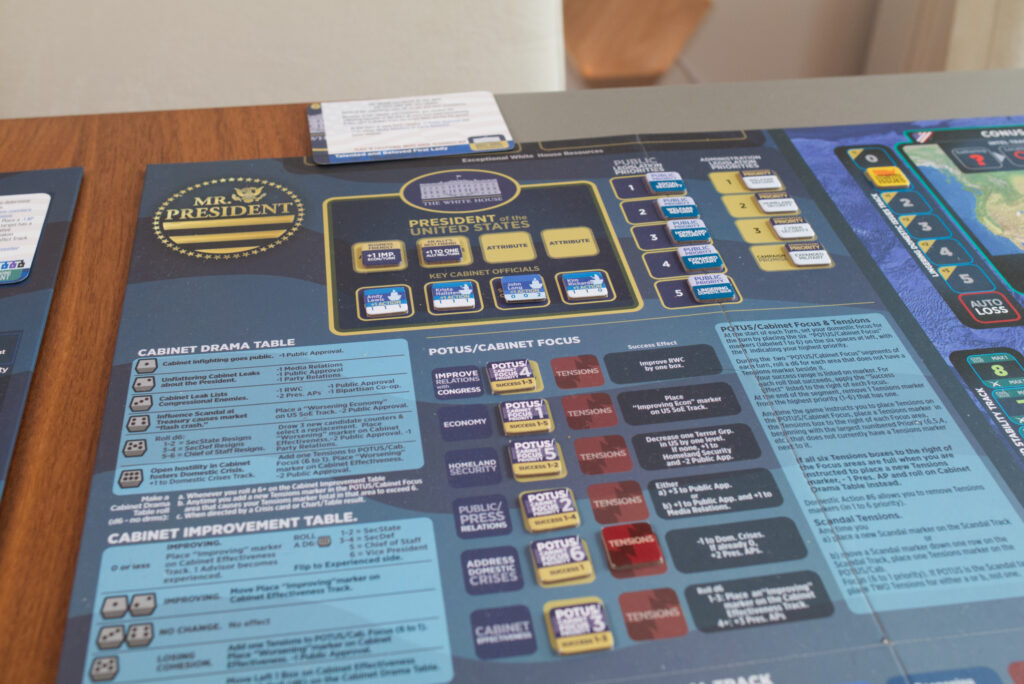
Somewhat strange, there isn’t a single main board in Mr. President but also a secondary main board. It contains a hodgepodge of different tracks, from the race for nuclear missiles via strategic research over the intensity of conflicts in the world to the legislation process and the administrations relation to congress or the media. The decision to break this out into a second board seems mainly motivated by the fact that there was just too much stuff to track to put it all on one main board. I found myself wishing some frequently used elements of this secondary main board would have been on the central main board and vice versa. I won’t go into detail here, lets just sum it up as: even more tracks and chits.

The third board tracks conflicts once they turn from conflict to war. This is rather generic/abstract and tracks whatever wars might be happening on the central main board. I.e. there can be situations where this board is completely empty because the world is at peace – or – a lot can be happening here. The image below also shows the various booklets that come in the game: domestic charts, ally charts, world peer Russia acts, … most of them contain tables instructing the player which die to roll and what dice roll modifications (=DRM) might or might not be relevant. As an example, the turn sequence might tell you that the Allies and Rogues act, instructs you to draw a random chit to figure out which ones, and then tells you to go to a particular booklet and follow the flow chart there. Or a crisis card (more on them later) tells you something is happening and you need to check D3 which means open the Domestic Charts booklet to table 3 and that will tell you what to roll and what the consequences are. During the game, you’ll constantly find yourself searching for a particular booklet, going to the right chart, counting DRMs, rolling a die, perform consequences, put the booklet away again.
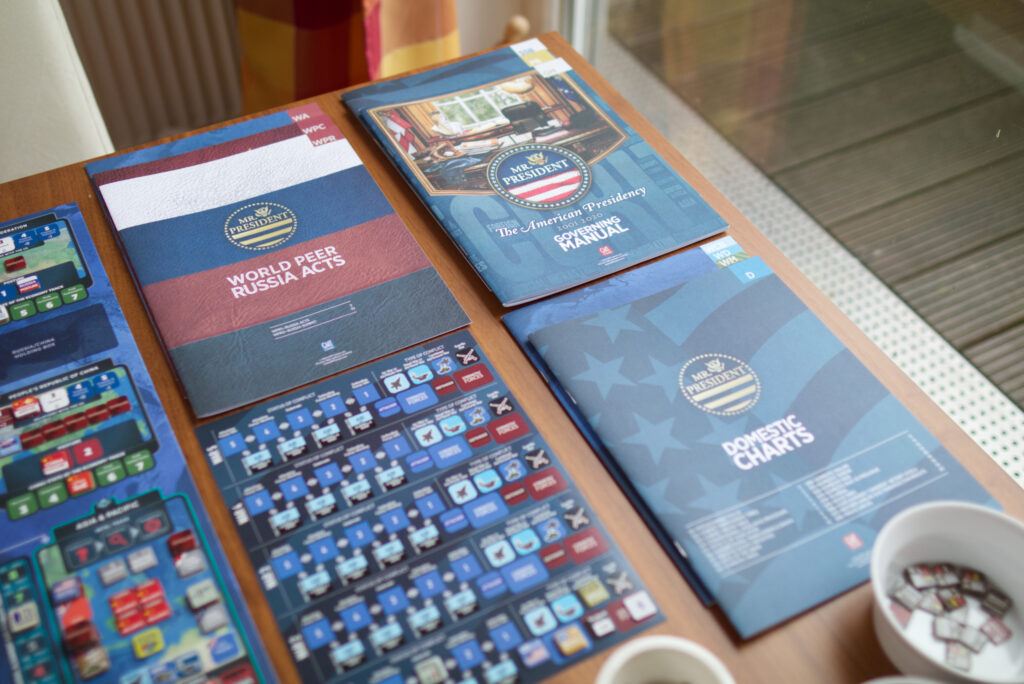
I left out a large number of setup steps from drawing certain cards, constructing decks, … but the general gist is: there is a lot packed into this game. It even comes with a scenario book that besides the standard sandbox scenario puts you as POTUS into various interesting historical situations. Oh yeah, and you’ll need about 7-8 cups to draw random chits from.
The Turn
Mr. President is played over four turns, each of which is a multi-hour commitment. Helpfully, there is a summation of the turn flow in the bottom left corner of the central main board. I say summation because some of the 50+ steps of a round actually contain multiple sub-steps, and those are not necessarily self-explanatory. Somewhat surprisingly, Mr. President manages to handle that part of the game’s complexity very well. One of the booklets contained in the game focusses solely on the turn sequence and allows the player to simply start at the beginning of a turn and follow along, learning the game as you go. So once the player has read a few very basic/fundamental rules and managed to complete setup, they can dive in immediately and consult the turn sequence booklet what to do. There is no “read these 45 pages before you can start”, which is great, but there is an obtuseness to the game nonetheless. For example, early in the beginning sequence of the turn, the game tells you to take one action as president. There are a whopping 33 possible actions you can take, presented on four double sided sheets of A4 and even those tell you what you can do, not what the consequences are. That information to a large part is only found when opening up those chart booklets.
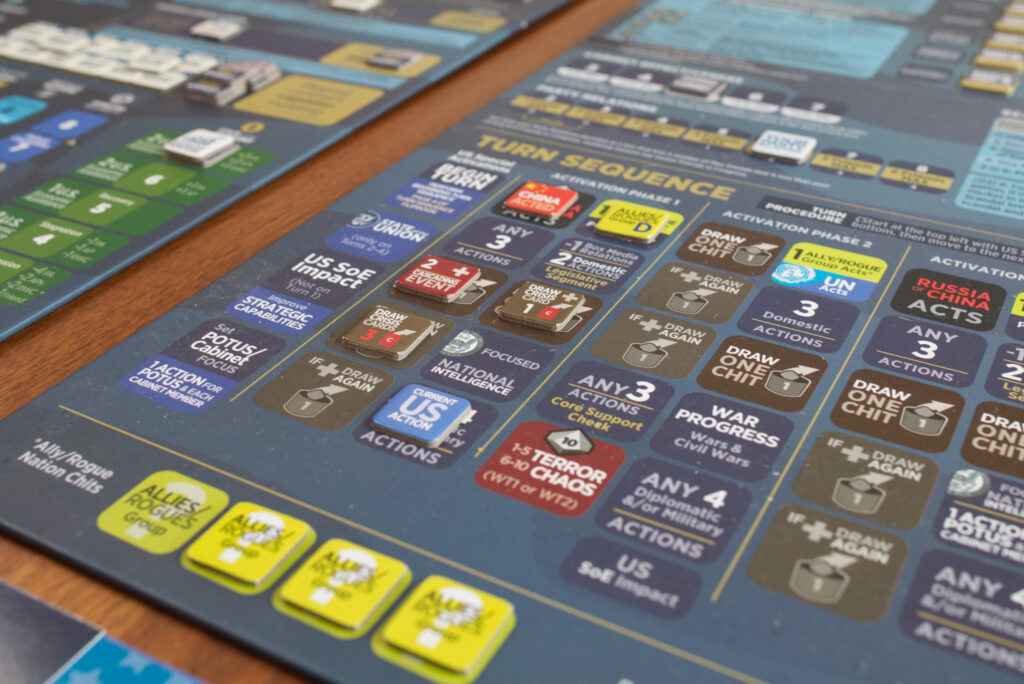
Broadly speaking, a turn of Mr. President consists of a start phase, 4 somewhat similar activation phases and an end of turn phase. Each activation phase is split into two parts (columns on the board), one where “the world is happening” and you have a chance to react to a small amount, followed by one where primarily you act and only one crisis interjects. Crises are created by drawing a random crisis chit that further instructs the player what to do, typically draw one or more cards from the crisis deck which is one of the key innovations in the game.
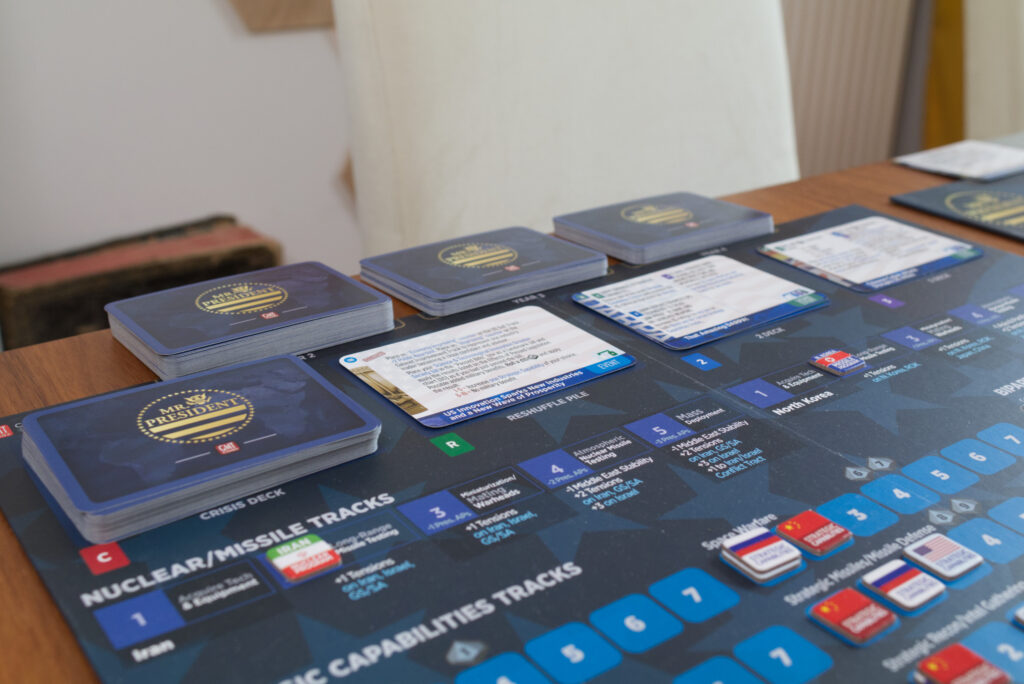
During setup, four decks are created that contain everything from your typical world crisis (famine here, cyber attacks there, …) to natural disasters and sometimes even helpful breakthroughs (so “crisis” is a bit misleading). Some of these cards are simply processed and then go out of the game. Others go into a reshuffle pile and come back next year. But the most interesting type of card are the cascading events: When they are first revealed, the usual bad things happen (e.g. a regional crisis increases) but then they are put into the “2” pile. These are looming crisis that aren’t over yet. The player knows about them and can sometimes do something so they won’t strike as hard the next time (e.g. by passing a matching piece of legislation in time). Other times, all that effort will be for naught because the card never comes up again and different crises arise.
The mechanism of cascading crisis cards in combination with the tick-for-tock of player actions vs automated world actions gives Mr. President a distinct “Pandemic on steroids”-feel where there are never enough player actions and something will always go out of hand.
End of Game
As the rules put it: Mr President is won on the domestic front and lost on the world stage. There are over a dozen auto-loss conditions that can end the game early such as the influence of one of the two main rivals getting too large. If you make it through the whole four years, you are judged by history based on the prestige points you collected throughout the game by achieving particularly noteworthy things. And the majority of those points come from doing something good for your constituency (e.g. passing landmark bills, fighting domestic problems), not trying to save the world.
When playing one of the historical scenarios, different rules apply and you will be measured based on the criteria of that scenario.
Other Noteworthy Mechanism
Mr. President is a game packed with mechanisms, from warfare and anti-terror actions, trade agreements to world economy, summits, nuclear arms races, … in general, it’s best described as: if there is any major thing you heard in the news over the last two decades that is related to US politics, it’s in this game. Health care bills, bipartisanship, refugee crises, cyber attacks, the UN, NATO, sanctions, the list goes on and on. So instead of going through everything, I will highlight a couple of mechanism I particularly enjoyed:
There are multiple aspects where the game stresses how difficult it is to do things completely on your own. For example, certain things on the world map are impossible to influence via your actions but can be done with the help of allies around the world. This is abstracted in a way where each of a fixed number of allies can be in a state of being estranged, close allies or very close allies. Based on that state of relationship, the game at various times of the turn sequence gives the player “free” actions where the US and the ally team up and together achieve something in the world (e.g. bring stability, investigate terrorism), followed by something the ally does on their own. So players naturally have an incentive to keep relationships up and invest in them, particular with those allies in regions of the world where problems are looming.
I also liked that conflicts don’t immediately turn into war but are something that the player can choose to try to resolve. In my first game, I for example nearly missed being awarded a noble piece price because the world as a whole was doing so well. I had helped end civil wars, fix local crises, etc. But it came at the cost of my public approval getting tanked and I had hardly gotten any legislation done.
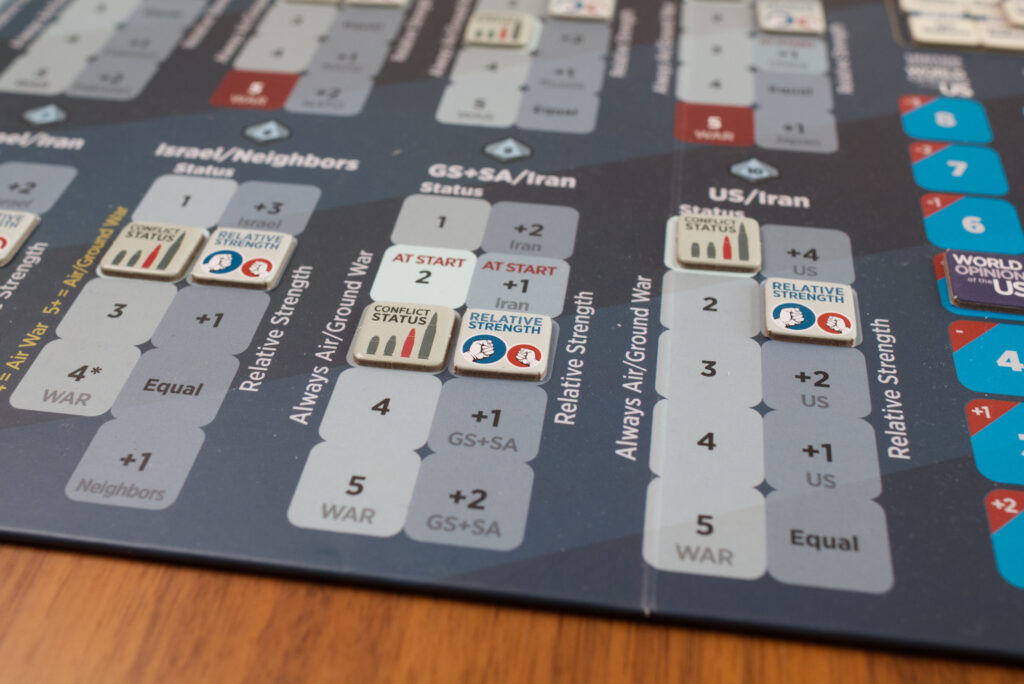
In another play, I did much better on the home front and my public approval was amazing, but tension kept rising in South Korea and the Asia & Pacific region got more and more under China’s influence. Despite there being various types of military units and a whole side board dedicated to that topic, I hardly ever had to use it and was able to go for more diplomatic solutions.
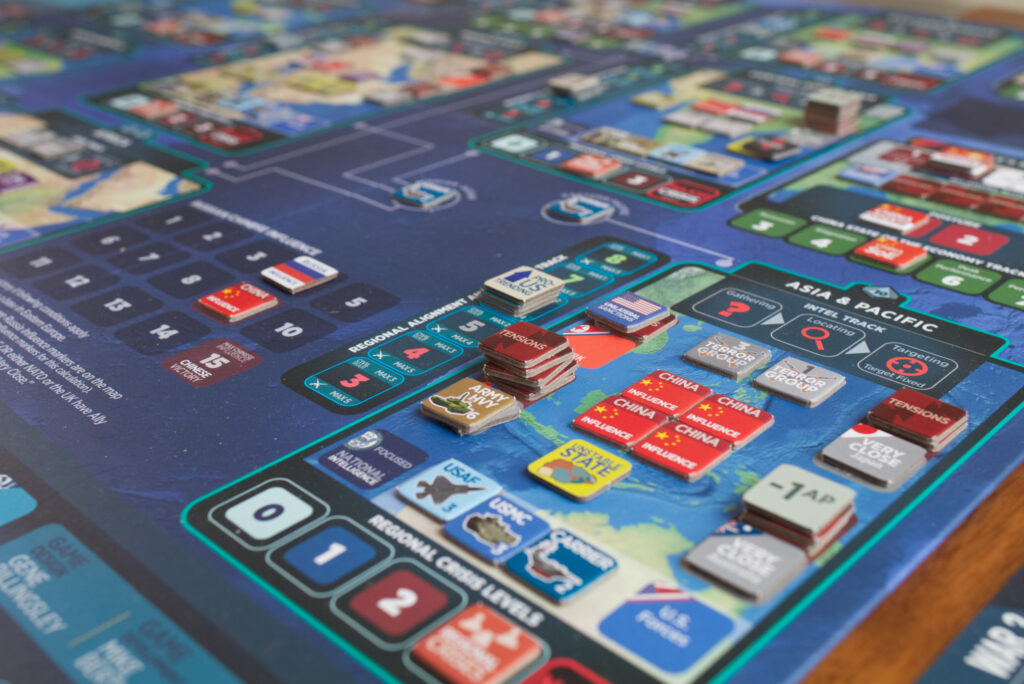
Conclusion
It’s seriously impressive how many aspects of both US and world politics the author has managed to pack into a single game. And to get all of it working at all is for me the biggest achievement of this game. As I hinted in the beginning, I haven’t had that many plays of Mr. President but so far, I didn’t encounter anything that felt broken or completely out of place. The only two things that came to mind were one incident where the game gave me a bonus due to some successful NSA work that got rid of two crisis cards and in that rare case it turned out both would have been positive events, so the whole thing didn’t make sense. The other are the number of typos or mistakes I’ve seen. In one case for example mixing up add and subtract for a DRM. Definitely keep the FAQ at hand.
I didn’t have any major military actions and therefore the whole war / military unit mechanisms would be my biggest question mark. But that might be simply due to play style or me by chance being able to prevent large scale war. Anyway, that whole part was the least interesting aspect of the game to me and kept me wondering if it couldn’t have been abstracted out of the game completely. The politics, influence and collaboration aspects were way more interesting to me!
One thing I found myself struggling with is the particular view on the world as shown by Mr. President. While it puts so much emphasis on co-operation and bipartisanship – which is lovely – it clearly paints its rivals as such: influence of China or Russia is always bad, a lot of other reactions of the rivals fall in the category of either they do something bad or they do nothing at all. This might be historically appropriate for the situation of being POTUS during 2001-2020, but I think Mr. President could have done more here. In a number of cases, the flavour text that comes with die roll results is excellent in painting a picture what is happening (e.g. summits going wrong), but for me were often too simplistic on the “why”. Why are they acting in that way and might there be an alternative solution? In this game, there exists so much opportunity to influence things to happen in different ways than they actually did, I guess I would have wished it to go one more step beyond and at least leave room for the possibility that those rivals don’t have to be always bad, but maybe could be just very challenging partners.
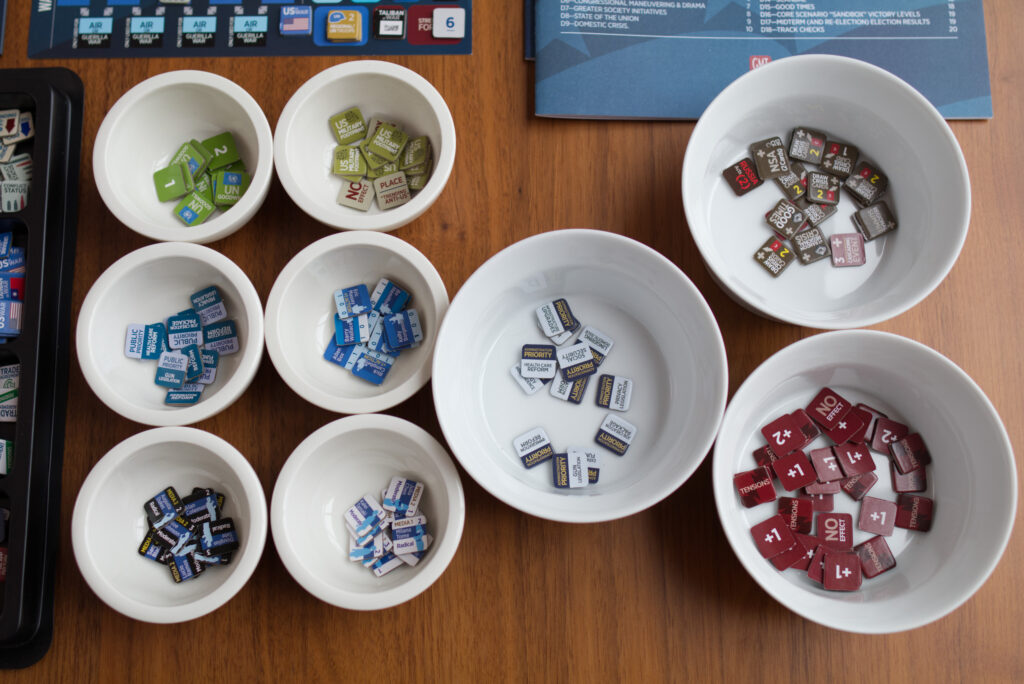
There were also a couple of user experience issues I ran into which surprised me as the board game industry as a whole has managed to evolve past them. For example, during setup, the rules mention certain tracks and chits but don’t have an image what/where they are. It was only by chance I later found the chart of all chits “hidden” in another booklet. Or the key cabinet members: when you place them on the board, they cover the label indicating which one is which and there is nothing on the chits or the board to explain which of the three attribute numbers is which. Can you remember which number was for domestic and which one for diplomatic stuff?
To not further bury the lead, I’ve come to the decision to sell my copy of Mr. President and not explore it any further. There are multiple reasons for it but I want to stress it’s a “me not you” kind of decision. As I wrote in the beginning, Mr. President for me is less a game and more a challenge. It fells like climbing mount Everest: if it’s for you, it’s great, and there are few experiences out there that will give you that kind of kick. But to enjoy it, it needs to be a serious commitment and you need to be the right kind of person. Otherwise it’s just a cold, painful and long climb up that particular summit.
After multiple hours of reading rules, setup, playing, reading BGG threads, playing some more, I noticed how I kept asking myself “is it fun yet?” like a small child might ask “are we there yet?” over and over again on a long road trip. There were two main aspects I had put my hope on when I bought Mr. President: emergent story telling and exploring the consequences of my actions on the world stage.
The first part never became a reality for me. There are two potential sources of story in Mr. President, the crisis cards and the flavour text in the flow charts / lookup tables. While the crisis cards somewhat worked (although it’s remarkable that they put the “what is happening” flavour text only at the bottom of the card), I often had forgotten them quickly after reading them because the next card already had me browsing in multiple booklets and reading through various DRMs and tables. The game kept pulling me out of the story and had me do minutes and hours of admin instead. Sometimes I felt like a librarian, checking the domestic booklet here, then cross referencing something in another rule book there, then weighing it against another option in an another booklet, etc. While at first I had hopes that this downtime would subside with more plays, I found there is just too much vital information in those booklets to really internalise it, which brings me to the second factor.
It’s difficult to really get a feel for what the consequences of your actions could be or likely will be. There might be devastating things waiting for you to happen, hidden in another row of a table you had been using multiple times already but you never rolled an 8 before. So whenever the game told me to make a choice, I felt rather going on instinct and learned knowledge from the real world (e.g. “if I do this, that might have bad consequences for my reputation”). This is especially apparent during your first play when the game tells you “pick an action” but it didn’t really tell you what to look out for. Should you try to get a regional crisis below a certain value or rather remove an opponent from congress? Move a military unit or start a trade agreement? Who knows. There is a section in one of the booklets that leads you through some example play, but getting to a point where you can read the board state and thus formulate the correct actions is really hard. All of this feels thematic in the sense of how a new politician stepping into the office of POTUS must feel, but fun it was not and could have been easily avoided.
There are two ways out of this situation: just keep playing the game and learning more and more about its mechanisms as you run into them (often suffering the consequences but at least knowing for the next time), or temporarily treating Mr. President as a pure simulational story generator and enjoying the ride. Even in a Vital Lacerda game, most players start with a good idea of what they want to achieve and at some point of the first 1-2 plays notice where they went wrong. Here however … let’s say it this way: I’ve never felt so lost and overwhelmed learning a game. And if I count all the hours I’ve spent learning and playing this game, I still have to answer the “is it fun yet?” question with no. John Company put me in the driver’s seat and even got me to buy two books on its subject because I wanted to know more about what’s going on in the game. With Mr. President, I felt like pulling the crank on a huge, incomprehensible machine, seeing how it would turn out this time, and wondering why I’m not reading a good book on the topic instead. With every play I learned more about how the game works and how I might be able to manipulate it, but for me it wasn’t fun for too long.
Where does that leave us? I guess for me Mr. President is like that TV series your friend recommended to you and advised you to stick with it until season three where it gets really good. If you are used to epic conflict games and or long solo experiences, most of what I have written probably won’t be relevant for you. I imagine that type of player buying Mr. President and then setting aside a table and a couple of weeks/months just to experience this game and having an amazing time! But is it still “playing” if such a large amount of time is spend on procedural stuff? It really begs the question how Mr. President would feel as a computer game where the player spends more time on thinking about consequences and less time performing them. For some people, seeing that ever changing system generating totally new situations all the time will be the primary factor of enjoyment, for others it will be the main thing keeping them from enjoying Mr. President. The important thing is to know which of both types you are and how much time you want to invest in this game …
